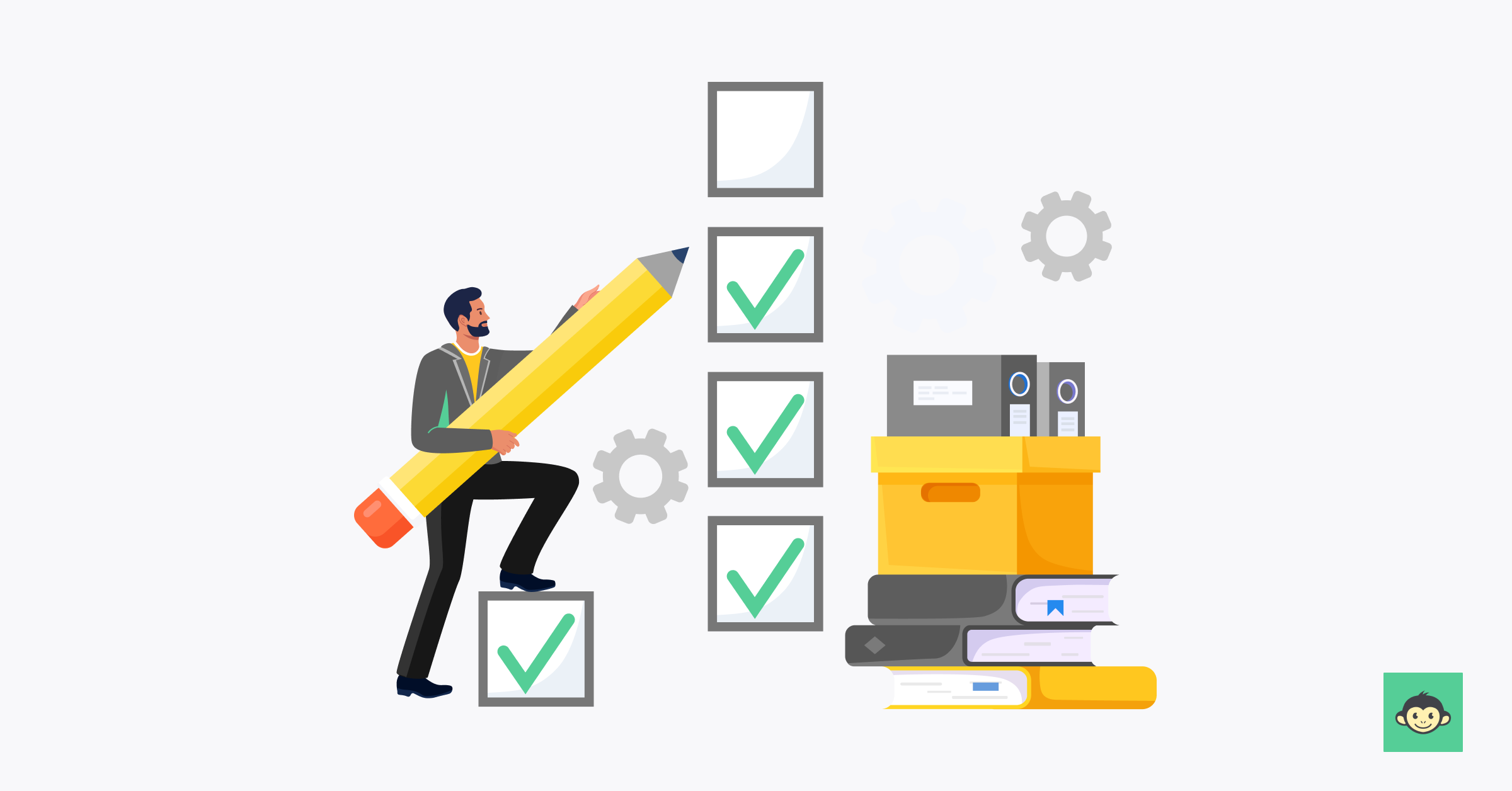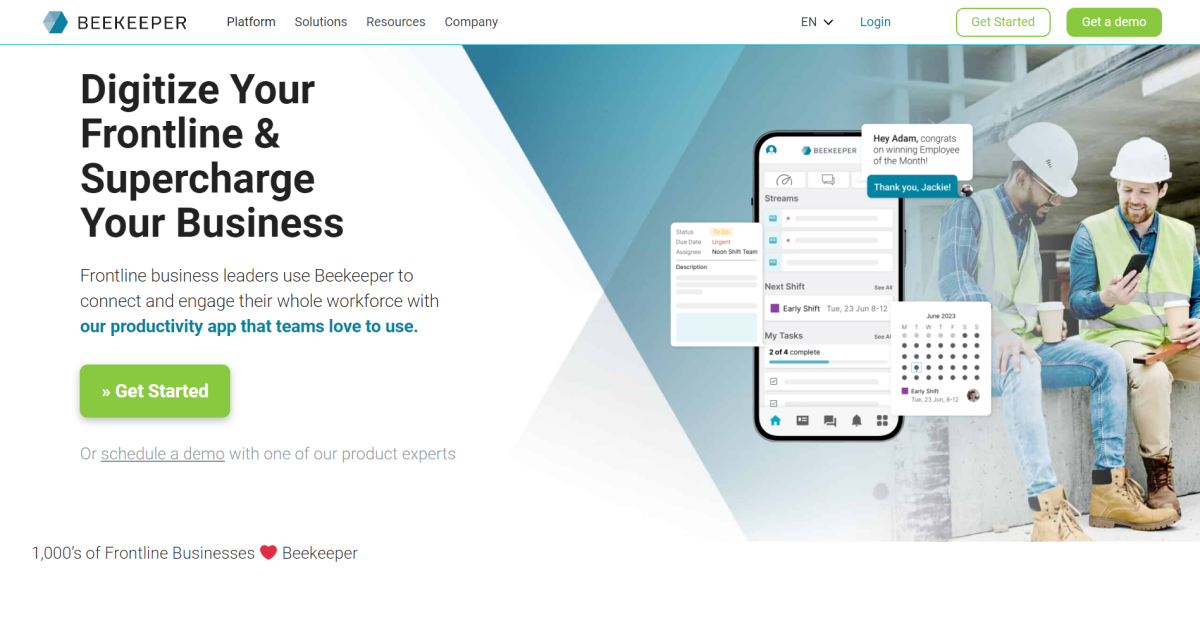How can good internal communication impact employee engagement in the workplace?

Picture this: you're strolling through the office, and instead of seeing droopy faces and shuffling feet, you're met with beaming smiles and energetic high-fives. Your team is buzzing with ideas, collaborating effortlessly, and achieving remarkable results.
The scene seems from a Hollywood feel-good movie. How did this magical transformation occur? The secret ingredient is none other than good old internal communication.
A report by McKinsey shows that if you communicate effectively with your employees, you can boost their productivity by 20-25%.
Effective internal communication is like the secret sauce that holds an organization together. It connects every single member of your team, from the C-suite to the interns, in a harmonious symphony of shared knowledge, clear expectations, and open dialogue.
It's the channel through which ideas flow, questions get answered, and feedback is heard. It's the backbone of a company culture that nurtures engagement, where employees feel valued, motivated, and connected to the bigger picture.
Now, you might be wondering, "That sounds great, but how can I actually achieve this internal communication nirvana?" The answer lies in the realm of employee engagement.
Employee engagement communication definition

Employee engagement refers to an organization's strategic and intentional communication efforts that foster a sense of connection, motivation, and commitment among employees. It involves creating an environment where employees feel valued, informed, and empowered to contribute to achieving the organization's goals.
At its core, employee engagement communications go beyond simply conveying information. It focuses on building meaningful relationships, establishing a shared understanding, and creating a positive employee experience.
It involves two-way communication channels that enable employees to provide feedback, ask questions, and share their thoughts and ideas. This type of communication encourages active participation, collaboration, and a sense of ownership among employees.
A study by Gallup shows that companies with highly engaged employees experience 21% higher profitability. It clearly indicates the importance of an engaged workforce and clear communication.
Here are some of the aspects encompassing employee engagement communication:
1) Transparent and open communication
This involves sharing relevant information openly, honestly, and in a timely manner. It helps employees understand the organization's vision, goals, and strategies and how their individual roles contribute to the bigger picture.
2) Feedback and recognition
Regular feedback and recognition are essential for employee engagement. Communication channels should be in place to provide constructive feedback, acknowledge achievements, and celebrate milestones. This helps employees feel valued and motivated to perform at their best.
3) Employee voice and inclusion
Employee engagement communication encourages employees to have a voice and actively participate in decision-making processes. It creates opportunities for employees to contribute ideas, opinions, and suggestions, fostering a sense of belonging and ownership within the organization.
4) Leadership communication
Effective leadership communication plays a critical role in boosting employee engagement. Leaders should be transparent, approachable, and capable of inspiring and motivating their teams. Clear communication of expectations, goals, and performance feedback from leaders helps employees understand their roles and perform effectively.
5) Internal communication channels and tools
Organizations should provide accessible and user-friendly communication channels and tools, such as team collaboration platforms, intranets, and social media platforms, to facilitate seamless and efficient employee communication.
6) Learning and development initiatives
Inclusive communication extends to fostering a culture of continuous learning and development. Organizations should communicate opportunities for skill enhancement, training programs, and career advancement. By keeping employees informed about learning initiatives, organizations empower them to grow professionally, reinforcing a commitment to their ongoing development.
7) Wellness and work-life balance communication
Employee engagement thrives when organizations prioritize and communicate initiatives related to employee well-being and work-life balance. Communicating wellness programs, mental health resources, and flexible work arrangements demonstrates a commitment to the holistic health of employees, contributing to a positive and balanced work environment.
8) Diversity, equity, and inclusion communication
To strengthen engagement, organizations should communicate their commitment to diversity, equity, and inclusion. Transparent communication about policies, initiatives, and progress in creating an inclusive workplace fosters a sense of belonging and diversity appreciation among employees.
9) Cross-functional collaboration communication
Effective communication should encourage cross-functional collaboration. This involves communicating about projects, initiatives, and achievements across different departments, creating a cohesive and interconnected work environment. It allows employees to understand the broader impact of their contributions.
10) Employee growth pathways
Communication about career growth and advancement pathways is vital for engagement. Organizations should transparently share information about career trajectories, promotion criteria, and opportunities for professional development. This empowers employees to envision their future within the organization, driving motivation and commitment.
Communication and employee engagement is about creating a culture of open dialogue, trust, and collaboration within the organization. Employees who feel engaged and connected are more likely to be motivated, productive, and committed to the organization's success.
How is communication linked to employee engagement?

Communication is intricately linked to employee engagement as it is a vital catalyst for creating a positive and engaging work environment. Here are some key ways in which communication influences employee engagement:
1) Clarity and direction
Effective communication ensures that employees clearly understand the organization's vision, mission, values, and strategic goals. When employees are aware of the bigger picture and how their work contributes to it, they feel a sense of purpose and direction, leading to higher levels of engagement.
2) Connection and belonging
Communication facilitates a sense of connection and belonging within the workplace. When employees receive regular updates, participate in team meetings, and have opportunities to interact with colleagues and managers, they feel more connected to the organization and their colleagues. This sense of the personal level of connection fosters a supportive work environment where employees are more engaged.
3) Feedback and recognition
Communication channels play a crucial role in providing feedback and recognition to employees. Regular and constructive feedback helps employees understand their performance, identify areas for improvement, and feel valued for their contributions. Recognition, whether through public acknowledgment, one-on-one appreciation, or rewards, boosts employee morale and enhances engagement.
4) Empowerment and involvement
Effective communication empowers employees by giving them a voice and involving them in decision-making processes. When employees are encouraged to share their ideas, opinions, and concerns, and their input is considered and valued, they feel a sense of ownership and involvement in the organization. This involvement leads to increased engagement and commitment.
5) Collaboration and teamwork
Communication is essential for fostering collaboration and teamwork. When information flows freely across teams and departments, employees can work together more effectively, share knowledge, and leverage collective strengths. This collaborative environment promotes engagement by encouraging cooperation, innovation, and a sense of shared success.
6) Trust and transparency
According to the Edelman Trust Barometer, 33% of workers do not trust their employers. So, open and honest communication is crucial in order to build trust between employees and the organization. Employees who can can trust their managers and colleagues share information more transparently, creating a positive work environment.
7) Goal alignment communication
Communication links employee engagement to organizational goals by ensuring that employees understand how their individual goals align with broader company objectives. Clearly communicating these connections fosters a sense of purpose and shows employees that their contributions are integral to achieving overarching goals.
8) Change management communication
During times of organizational change, effective communication is paramount. When employees receive transparent and timely information about changes, whether in processes, leadership, or structure, it minimizes uncertainty and anxiety. Clear communication during transitions helps maintain engagement by keeping employees informed and involved.
9) Personal and professional development communication
Communication about opportunities for personal and professional growth is a key factor in employee engagement. When organizations share information about training programs, mentorship initiatives, and skill development opportunities, it signals a commitment to investing in employees' long-term success, fostering a culture of continuous improvement and engagement.
Trust is a cornerstone of engagement, as it enables employees to feel safe, express themselves freely, and take risks without fear of negative consequences.
How can effective communication enhance employee morale and engagement?

Effective communication isn't just about transmitting information; it's about fostering a workplace culture where every team member feels heard, valued, and connected.
- The ripple effect of clear expectations: Ever been in a situation where you're unsure about your tasks or goals? It's like navigating through a maze blindfolded. Effective communication ensures everyone is on the same page. Clear expectations lead to a sense of direction, reducing confusion and frustration.
- Recognition that resonates: Picture this: your hard work acknowledged in front of the whole team. Feels good, right? Regular and genuine recognition creates a positive loop, motivating employees to give their best. It's not just about the occasional pat on the back – it's about making employees feel seen and valued.
- Open dialogue, closed gaps: A culture of open communication fosters trust. When employees feel their opinions matter, they become more engaged. Encourage feedback, ideas, and suggestions. It's not just about talking to your team; it's about creating a space where they feel comfortable talking to you.
- Constructive criticism, not condemnation: Nobody's perfect, and that includes your team. However, how you deliver feedback matters. Instead of focusing on the negative, emphasize growth. Constructive criticism, delivered with empathy, becomes a tool for improvement rather than a source of demotivation.
- The power of transparency: Imagine being in the dark about your company's future. It's unsettling, right? Transparency breeds trust. Keep your team in the loop about organizational changes, challenges, and successes. When employees understand the bigger picture, they're more likely to stay committed and engaged.
- Celebrating wins, big and small: From closing a major deal to fixing the office coffee machine – celebrate it all! Small victories build a positive atmosphere. Regularly acknowledging achievements, both individual and team-based, creates a culture of success, boosting morale in the process.
- Flexibility fuels engagement: In today's dynamic work environment, flexibility is key. Effective communication involves understanding individual needs. Whether it's flexible work hours, remote options, or personalized development plans, tailoring communication to meet individual preferences enhances job satisfaction and, consequently, engagement.
Employee engagement communication challenges

While employee engagement communication is essential, it can also present challenges that organizations need to navigate. Addressing these challenges requires a proactive approach to employee engagement communication.
It involves streamlining communication channels, providing training, creating inclusive feedback mechanisms, fostering a culture of open and transparent communication, and actively involving managers in the communication process. Here are some common challenges faced in improving employee engagement and communication:
1) Information overload
In today's digital age, employees are often bombarded with overwhelming information from various sources, such as emails, instant messages, and company-wide announcements. This information overload can make it challenging for important messages to stand out and for employees to prioritize their attention effectively.
2) Communication barriers
Organizations with diverse workforces may face communication barriers due to language differences, cultural variations, or geographical distances. These barriers can hinder effective communication and make it difficult to ensure that all employees receive and understand critical information equally.
3) Lack of feedback channels
One-sided communication, where information flows from the top down without opportunities for employee feedback, can hinder engagement. Employees need channels to provide input, ask questions, and share their ideas and concerns. Without these feedback mechanisms, communication can become a one-way street, leading to disengagement and frustration.
4) Remote work and digital communication
With the rise of remote work, organizations face the challenge of maintaining effective communication when employees are dispersed across different locations. Digital communication tools such as email, video conferencing, and collaboration platforms play a crucial role, but they also bring their own set of challenges, including misinterpretation of tone and reduced opportunities for spontaneous interactions.
5) Lack of managerial support
Managers play a pivotal role in employee engagement communication. However, if managers lack good communication skills or fail to prioritize and effectively convey important messages, it can create gaps in communication and hinder engagement. Employees need supportive and communicative managers who actively engage with their teams.
6) Inconsistent messaging
When communication is inconsistent or contradictory, it can lead to confusion and erode trust among employees. Misalignment between leadership messages and actions can also create skepticism and disengagement of remote employees. Consistency in messaging is crucial to ensure that employees receive accurate and coherent information.
7) Resistance to change
Introducing new communication channels or tools may face resistance from employees who are accustomed to traditional methods. Some employees may feel overwhelmed or hesitant to adopt new technologies or communication practices, leading to a lack of engagement with the new initiatives.
8) Generational communication gaps
The presence of multi-generational workforces introduces challenges in communication styles and preferences. Varying communication preferences between generations, such as Baby Boomers, Gen X, Millennials, and Gen Z, can create gaps in understanding and engagement if not addressed effectively.
9) Lack of accessibility and inclusivity
Accessibility issues, such as inadequate support for differently-abled employees or language barriers, can impede effective communication. Inclusive communication ensures that all employees, regardless of their abilities or linguistic background, can fully engage with and comprehend the information being shared.
10) Overreliance on written communication
Relying solely on written communication may pose challenges, especially when dealing with complex information. Some employees may prefer visual or verbal communication styles. Overreliance on written channels without diversifying communication methods can result in information being misunderstood or overlooked.
11) Time zone challenges in global teams
In globally dispersed teams, varying time zones can create difficulties in synchronizing communication. Critical updates or important announcements may be delivered during non-business hours for some team members, impacting their ability to engage in real-time discussions and leading to a sense of exclusion.
12) Employee burnout from constant connectivity
The constant connectivity facilitated by digital communication tools can contribute to employee burnout. The expectation to be constantly available and responsive, especially in remote work settings, may lead to fatigue and disengagement. Balancing effective communication without overwhelming employees is crucial for maintaining engagement and well-being.
By overcoming these challenges, organizations can create a communication environment that enhances employee engagement and contributes to overall success.
How to frame your employee engagement communication strategy?

To frame an effective employee engagement communication strategy, it's important to establish clear goals that align with your organization's objectives. Here are some clear objectives to consider when developing your strategy:
1) Foster a sense of purpose and direction: A primary goal of employee engagement communication is to provide employees with a clear understanding of the organization's vision, mission, and values. By effectively communicating the purpose and direction of the organization, employees can connect their individual roles to the broader goals, fostering a sense of purpose and alignment.
2) Enhance employee connection and belonging: Communication should foster a sense of connection and belonging among employees. This involves creating opportunities for interaction, encouraging open dialogue, and promoting a supportive and inclusive work environment. The goal is to establish strong relationships among team members across departments and with leadership.
3) Promote transparent and timely information flow: Communication should be transparent, ensuring that important information is shared openly and consistently throughout the organization.
Companies should strive to provide employees with the information they need to perform their roles effectively, make informed decisions, and understand organizational changes or updates. Timeliness is crucial to prevent rumors or misinformation from spreading.
4) Encourage two-way communication and feedback: Establishing channels for two-way communication and feedback is essential to foster employee engagement. Organizations must create an environment where employees feel comfortable expressing their ideas, concerns, and feedback. Actively listening to employees' perspectives and providing opportunities for them to share their thoughts is also crucial.
5) Recognize and celebrate employee contributions: Communication should include mechanisms for recognizing and celebrating employee achievements and contributions. The goal is to foster a culture of appreciation and recognition, making employees feel valued and motivated. Highlighting individual and team successes helps build morale, personal connections, and a sense of accomplishment.
6) Empower employees and encourage collaboration: Businesses should empower employees by involving them in decision-making processes, encouraging their input, and promoting collaboration. They must create a culture where employees feel empowered to contribute their ideas, suggestions, and expertise, fostering a sense of ownership and engagement in their work.
7) Develop strong leadership communication: Leadership communication is crucial to increase employee engagement. Leaders need to communicate effectively, share the organization's vision and goals, and provide regular updates and feedback. Transparent and authentic leadership communication builds trust and inspires employees to engage in their work actively.
Employee engagement communication best practices

Here are the top 10 employee engagement communication best practices to build your own strategic internal communication strategy for organizational success:
- Create a comprehensive employee communication strategy that outlines objectives, target audiences, key messages, channels, and a timeline for communication initiatives.
- Employ a mix of communication channels to reach employees effectively.
- Consider different departments, teams, or generations' unique needs, preferences, and communication styles to ensure messages resonate with each audience.
- Establish channels that encourage open dialogue and feedback.
- Actively listen to employees' concerns, suggestions, and feedback. Respond promptly and genuinely to demonstrate that their input is valued.
- While digital communication is convenient, face-to-face interaction remains essential.
- Ensure that senior leaders across the organization consistently communicate key messages, goals, and values.
- Regularly acknowledge and celebrate employee achievements and milestones.
- During periods of change, such as mergers, restructuring, or new initiatives, provide clear and transparent communication to address employee concerns, provide updates, and offer support.
- Collect feedback, measure engagement levels, and solicit suggestions for improvement. Use data to refine your approach and adapt to evolving employee needs.
Two-way communication emphasizing organizational goals

Imagine it as a lively conversation, not just a monologue of instructions. In this dynamic exchange, the spotlight is on discussing and understanding organizational goals.
First off, it's not just about the higher-ups broadcasting the grand plan. It's about opening the floor for everyone to chime in. Two-way communication means inviting ideas, questions, and suggestions from every corner of the office. After all, the genius idea that propels your organization forward might be brewing in the mind of the intern in the corner cubicle!
But it's a dance, not a solo act. Two-way communication is about active listening. It's about the higher-ups tuning in to the insights and concerns of the team. It's a collaborative effort where every voice contributes to the symphony of success.
And let's not forget the magic of clarity. When everyone understands the organizational goals, it's like having a GPS for success. No one's wandering aimlessly; everyone's moving in sync towards a common destination. It's not just about knowing the 'what'; it's about comprehending the 'why' and 'how' that turns a goal into a shared mission.
In this two-way street, feedback is the currency. It's not a top-down critique session; it's a dialogue where constructive criticism and fresh ideas flow freely. It's a culture where improvement is a collective effort, and everyone has a stake in refining the path to success.
What is internal engagement in the workplace?
Internal engagement in the workplace? It's not just another corporate buzzword – it's the heartbeat of a thriving organization. Picture this: it's not just about punching in and out; it's about feeling the pulse of your workplace, and being a part of something bigger than the daily grind.
At its core, internal engagement is the secret sauce that turns a group of individuals into a cohesive, motivated team. It's the glue that binds employees to their work, their colleagues, and the overarching goals of the company. It's the difference between showing up and being all in.
Think of it as the emotional commitment employees have towards their organization. It's that spark that transforms a job into a passion, a duty into a calling. Internal engagement is about creating an environment where every team member feels valued, heard, and connected to the broader mission.
It's not just about team-building retreats and fancy perks; it's about the everyday interactions, the meaningful conversations, and the genuine recognition that fuels a positive workplace culture. When internal engagement is thriving, you don't just have employees; you have advocates, champions who bring their A-game because they genuinely care.
Internal communications and employee engagement

The symbiotic relationship between internal communications and employee engagement is pivotal. Effective internal communication serves as the lifeblood of organizational connectivity, fostering a sense of unity and purpose among team members.
Clear and transparent communication channels lay the foundation for informed decision-making, ensuring that employees are aligned with the company's goals and strategies. When individuals are privy to the larger organizational narrative, they become stakeholders in the mission, propelling their engagement to new heights.
Furthermore, timely and relevant updates create a culture of trust and openness. Employees appreciate being kept in the loop about company developments, changes, and successes. This transparency not only instills confidence but also empowers individuals to contribute meaningfully to the collective vision.
Engagement thrives on dialogue. Effective employee communication encourages a two-way street, where feedback and suggestions are not only welcomed but actively sought. This exchange not only enhances the quality of decision-making but also cultivates a culture where every team member's voice is valued.
A strategic approach to internal communications leverages various platforms and tools, from company-wide emails to collaborative platforms, ensuring that information reaches every corner of the organization. This inclusivity fosters a sense of belonging and keeps remote or dispersed teams connected, amplifying engagement across diverse work environments.
What should management do regarding communication between employees?

"Communication is key" might sound like a cliché, but trust me, in the workplace, it's the secret sauce for a harmonious and productive environment. So, here are the gems to polish up that communication game between your stellar employees:
- Foster an open-door policy: Imagine your office door as a portal to transparency. Encourage an open-door policy where employees feel comfortable popping in for a quick chat. It's not just about addressing concerns; it's about creating a culture where communication flows seamlessly, unburdened by unnecessary barriers.
- Embrace technology wisely: Sure, emails have their place, but in the era of lightning-fast communication, don't shy away from embracing technology that fosters real-time interaction. Whether it's a collaboration platform, instant messaging, or video conferencing, leverage tools that make communication efficient and dynamic.
- Regular check-ins, not just about the tasks: It's not a game of micromanagement; it's about genuine interest. Regular check-ins shouldn't just revolve around tasks and deadlines; delve into how your employees are feeling. Understanding their aspirations, concerns, and challenges builds a bridge of empathy and strengthens the manager-employee bond.
- Clarify expectations clearly: Communication breakdown often happens when expectations are unclear. Managers, take the lead in setting clear expectations for tasks, projects, and goals. When everyone knows the game plan, the team moves in sync, avoiding confusion and frustration.
- Celebrate diversity in communication styles: Ever noticed how some folks love a face-to-face chat while others prefer dropping a quick message? Acknowledge and celebrate these diverse communication styles. A one-size-fits-all approach doesn't cut it. Embrace the richness that different communication preferences bring to the table.
- Constructive feedback, not criticism: Feedback is a gift, but the wrapping matters. When providing feedback, focus on the constructive angle. Highlight what went well and offer suggestions for improvement. It's not about pointing fingers; it's about nurturing growth and development.
- Promote team-building activities: Facilitate team-building activities that encourage employees to communicate and collaborate in a relaxed setting. This helps break down communication barriers and fosters stronger interpersonal relationships.
- Provide communication training: Equip employees with communication skills through training sessions and workshops. This can include active listening, effective speaking, and conflict resolution, empowering them to communicate more effectively.
- Encourage cross-departmental collaboration: Create opportunities for employees from different departments to work together on projects or initiatives. This cross-departmental collaboration enhances understanding and breaks down silos, leading to more cohesive communication across the organization.
5 Top communication tools for employee engagement
Effective communication lies at the heart of employee engagement, and in the digital age, innovative tools have become indispensable for fostering collaboration and connectivity within the workplace.
Let's explore five dynamic communication tools that not only facilitate seamless interaction but also contribute to enhancing employee engagement – Slack, Microsoft Teams, Zoom, Trello, and Beekeeper.
1. Slack

- Real-time collaboration: Slack fosters instant communication through channels and direct messages, ensuring teams can engage in real-time discussions and stay connected.
- File sharing and collaboration: The platform allows seamless sharing of files and collaborative editing, promoting transparency and teamwork.
- Integration capabilities: Slack integrates with a multitude of third-party apps, providing a customizable environment tailored to the specific needs of teams.
- Channel organization: Channels can be organized by project, department, or topic, facilitating a structured approach to communication and information retrieval.
- Searchable message archives: Slack's searchable message archives make it easy for users to find past conversations and reference important information.
Learn more about Slack
2. Microsoft Teams

- All-in-one collaboration: Microsoft Teams combines chat, video conferencing, file storage, and app integration within the Microsoft 365 suite, offering a comprehensive collaboration solution.
- Virtual meetings and webinars: Teams facilitates virtual face-to-face interactions through video meetings and webinars, enhancing the sense of connection among team members.
- Document collaboration: Integrated with Microsoft Office, Teams allows real-time collaboration on documents, fostering teamwork and efficiency.
- Channel-based organization: Teams can be organized into channels, streamlining communication within specific projects or departments.
- Security features: Teams prioritizes security with features like multi-factor authentication and data encryption, ensuring a secure collaboration environment.
Learn more about Microsoft Teams
3. Zoom

- Versatile video conferencing: Zoom's user-friendly platform supports various video conferencing formats, from one-on-one meetings to large-scale webinars and virtual events.
- Breakout rooms: The breakout rooms feature allows teams to split into smaller groups during meetings, promoting focused discussions and collaboration.
- Interactive features: Zoom offers features like chat, reactions, and screen sharing, enhancing engagement and participation during virtual meetings.
- Recording and transcription: Meetings can be recorded for future reference, and automated transcriptions provide detailed documentation of discussions.
- Integration capabilities: Zoom integrates with various applications, extending its functionality and adapting to different organizational needs.
Learn more about Zoom
4. Trello

- Visual project management: Trello's boards, lists, and cards provide a visual representation of project workflows, aiding in project management and task organization.
- Collaborative task management: Trello promotes collaboration by allowing team members to comment, attach files, and update task statuses directly on boards.
- Customizable boards: Users can customize boards to fit their workflow, making Trello adaptable to different project management styles.
- Checklists and due dates: Checklists and due dates within cards help teams track progress and meet project deadlines.
- Activity logs: Trello provides activity logs, allowing users to see a timeline of changes and contributions made by team members.
Learn more about Trello
5. Beekeeper

- Inclusive communication: Beekeeper is designed to include frontline and deskless workers, ensuring that all employees can participate in communication efforts.
- Employee recognition: The platform includes features for recognizing and celebrating employee achievements, fostering a positive workplace culture.
- Multilingual support: With multilingual capabilities, Beekeeper accommodates diverse workforces and ensures communication is accessible to all.
- Company-wide announcements: Beekeeper allows for the dissemination of company-wide announcements, keeping all employees informed about important updates.
Learn more about Beekeeper
Employee engagement communication examples
Employee engagement communication examples highlight how organizations can effectively foster a sense of connection and commitment among their workforce. These strategies go beyond basic information dissemination, focusing on creating a positive and inclusive work environment.
- Regular town hall meetings: Town hall meetings provide a platform for senior leadership to share organizational updates, celebrate successes, and address employee concerns. These meetings promote transparency, align employees with the company's vision, and encourage open dialogue.
- Employee Resource Groups (ERGs): ERGs are voluntary, employee-led groups that focus on shared identities or experiences, such as ethnicity, gender, or interests. These groups foster a sense of community, support diversity and inclusion efforts, and provide valuable insights to leadership on employee needs.
- Storytelling campaigns: Highlighting employee stories through internal newsletters, intranets, or social media platforms can create a more personal connection within the organization. Sharing success stories, career growth journeys, and personal achievements can inspire and motivate employees.
- Interactive workshops and training sessions: Conducting workshops that focus on skill development, team building, and innovation encourages active participation. These sessions can include interactive activities, group discussions, and hands-on learning, fostering collaboration and engagement.
- Internal mentorship programs: Establishing mentorship programs pairs experienced employees with newer team members to provide guidance, support, and knowledge sharing. This not only helps in professional development but also builds strong interpersonal relationships and a supportive work culture.
- Gamified engagement platforms: Implementing gamified platforms for engagement activities can boost motivation and participation. These platforms can include leaderboards, rewards for achievements, and challenges that promote healthy competition and recognition.
Why management should focus on proactive communication in the workplace?
Proactive communication serves as a linchpin for organizational success, fostering a culture of transparency, clarity, and responsiveness.
Firstly, it mitigates potential issues before they escalate. By anticipating concerns, providing relevant information, and addressing queries preemptively, management can avert misunderstandings and ensure that the team is well-informed, thereby fostering a harmonious work environment.
Moreover, proactive communication builds trust. When management takes the initiative to share updates, insights, and strategic directions without being prompted, it demonstrates a commitment to openness. This transparency is fundamental in cultivating a sense of trust among employees, who appreciate being kept in the loop about the company's trajectory.
Additionally, it enhances organizational agility. In a fast-paced business landscape, being proactive in disseminating crucial information enables teams to adapt swiftly to changes. Whether it's a shift in team dynamics or internal restructuring, proactive communication empowers employees to align themselves with evolving organizational goals.
Furthermore, it boosts employee morale and engagement. Feeling uninformed can lead to disengagement and a sense of detachment from the company's mission. Proactive communication demonstrates that management values the contributions of every team member, fostering a positive workplace culture.
How to measure communication in the workplace?

Effectively measuring communication in the workplace is crucial for fostering a healthy and productive organizational environment. One potent method that stands out is the utilization of anonymous employee engagement surveys. Here's why this approach proves to be the gold standard for assessing communication efficacy.
Firstly, anonymity in surveys encourages candid and unfiltered feedback. Employees are more likely to express their genuine thoughts, concerns, and suggestions without fear of repercussions. This transparency is pivotal in understanding the real pulse of communication within the organization.
Secondly, anonymous surveys promote inclusivity. By eliminating the fear of potential bias or judgment, employees from all levels and departments feel empowered to contribute their insights. This broadens the scope of feedback, capturing perspectives that may otherwise remain unheard.
Furthermore, these surveys provide a quantitative foundation for evaluating communication effectiveness. Questions can be tailored to assess the clarity of messaging, the frequency of communication, and the perceived openness of channels. With numerical data in hand, organizations can pinpoint areas of strength and areas that require improvement.
The anonymity factor also mitigates the Hawthorne effect, wherein individuals may alter their behavior due to the awareness of being observed. By allowing employees to share their thoughts without the burden of identification, organizations gain a more accurate representation of the communication landscape.
Moreover, these surveys serve as a benchmarking tool over time. Regularly conducted anonymous surveys provide a longitudinal view of communication trends, enabling organizations to track progress, identify patterns, and implement targeted interventions.
25+ Employee engagement communication questions

Here are 25+ communication questions to facilitate effective communication and boost employee engagement within your organization:
- How can we improve employee engagement and employee satisfaction?
- What internal communications channels do employees find most effective for receiving important updates?
- How can we encourage employees to participate in two-way communication actively?
- Are any barriers or challenges hindering effective communication within our organization?
- What strategies can we implement to further poor communication and ensure consistent and aligned leadership communication?
- How can we create a culture of transparency and openness in our communication practices?
- What feedback mechanisms can we introduce to gather employee insights and suggestions?
- Are there any specific topics or information that employees feel is currently lacking in our communication efforts?
- How can we better communicate and manage change to minimize uncertainty and maintain engagement?
- Are there any opportunities to leverage technology or digital platforms to enhance communication?
- What recognition and celebration initiatives can we implement to foster a culture of appreciation?
- How can we improve communication during remote work or for geographically dispersed teams?
- ow can we measure the effectiveness of our communication efforts and gather employee feedback on communication practices?
- How can we personalize communication to address the diverse needs and preferences of our employees?
- What role can employee resource groups play in improving our communication efforts?
- How can we ensure that new hires are effectively integrated into our communication channels?
- Are there opportunities to provide communication training for managers and team leaders?
- How can we maintain engagement and morale during organizational restructuring or downsizing?
- What methods can we use to ensure that frontline employees receive important communications promptly?
- How can we use storytelling to enhance our internal communication and make it more relatable?
- What role can visual communication tools (like infographics or videos) play in our communication strategy?
- How can we ensure that communication is inclusive and accessible to all employees, including those with disabilities?
- What steps can we take to improve cross-departmental communication and collaboration?
- How can we involve employees in the development and dissemination of communication materials?
- Are there any industry best practices in communication that we can adopt to enhance engagement?
- How can we effectively communicate our organization's mission, vision, and values to inspire employees?
- What role can social media play in our internal communication strategy?
These questions serve as a starting point to evaluate and enhance your employee engagement communication strategies, ensuring that communication practices align with employee needs and contribute to a more engaged employee workforce.
Conclusion
Effective employee engagement communication is crucial for creating a positive and productive work environment. Organizations can enhance employee engagement by establishing clear goals, utilizing diverse communication channels, promoting two-way communication, and fostering transparency.
Companies must also regularly evaluate and adjust communication efforts based on employee feedback and engagement metrics to ensure improvement.
Suppose you want to measure engagement at your workplace the right way and collect employee feedback. In that case, CultureMonkey can help you listen to your employees better and create more growth opportunities with its employee engagement survey platform.
It offers multiple survey options such as eNPS, pulse surveys, and employee life cycle surveys to accurately measure your employees' engagement levels and improve them.
Companies can take anonymous feedback in real-time and ensure their employees are not facing any major roadblocks. It can also help find areas of focus that the management needs to work on to improve employee engagement.
CultureMonkey has been recognized as a high-performer employee engagement platform by G2 for Winter 2023. It is also being used by more than 200K+ employees globally.
FAQs
1) How can communication technology and tools improve employee engagement?
Effective communication technology and tools can significantly enhance employee engagement by facilitating real-time and efficient communication. Platforms such as team collaboration tools and mobile platforms enable instant information sharing, remote collaboration, and feedback gathering.
2) What role does leadership communication play in employee engagement?
Leadership communication plays a crucial role in employee engagement as it sets the organization's tone, direction, and vision. When leaders communicate openly, transparently, and authentically, they build trust, inspire confidence, and create a sense of purpose among employees.
3) How can organizations ensure effective communication during times of change?
During times of change, effective communication strategies become even more critical to maintain employee engagement. Organizations can ensure effective communication by adopting a proactive and transparent approach. This involves providing regular updates on the change process, sharing the reasons behind the change, addressing employee concerns, and actively involving employees in decision-making when possible.
4) How can organizations measure the effectiveness of their employee engagement communication?
Measuring the effectiveness of employee engagement communication is essential to gauge its impact and make informed improvements. Organizations can use various metrics to evaluate communication efforts. Employee surveys or feedback mechanisms can assess communication satisfaction, clarity, and relevance.
5) How can organizations address communication challenges in a remote work environment?
Remote work presents unique communication challenges, but organizations can overcome them to maintain employee engagement. Clear and frequent communication becomes crucial. Emphasizing the importance of work-life balance and providing opportunities for virtual social interactions can also foster a sense of belonging.
6) How does open-door policy contribute to employee engagement communication?
An open-door policy enhances employee engagement communication by promoting transparency and trust between employees and management. It encourages open dialogue, allowing employees to share concerns, ideas, and feedback directly with leaders. This approach fosters a sense of inclusivity and belonging, facilitates prompt problem-solving. By making leadership accessible, it ensures a continuous flow of communication, leading to a more engaged workforce.



